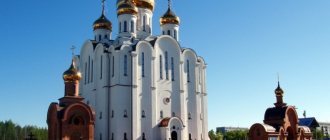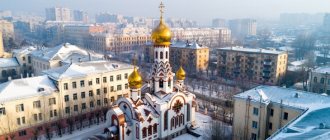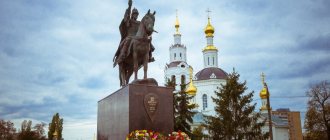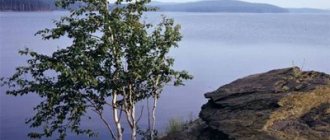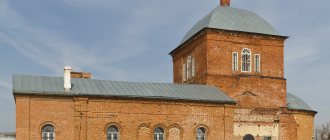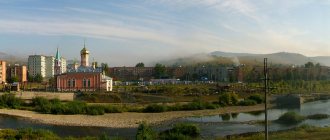Sights of Zarinsk.
The city of Zarinsk today. The city of Zarinsk is located in the Altai Territory, 100 km northeast of Barnaul. The Zarinsky district includes 50 settlements. Geographically located on the Biysk-Chumysh Upland, on the Chumysh River (a tributary of the Ob). This is a very young city, it was founded in 1979. Large transport hub - there is a railway station.
The area of the city is 79.16 km/sq., the population is 46 thousand people.
Book a hotel in Zorinsk on Booking.com =>>
General information about Zarinsk
OJSC Altai-Koks is located in Zarinsk - it is a city-forming enterprise. In addition, the city has a large construction company and agricultural processing enterprises. Zarinsky district is rich in various minerals. Deposits of construction sands and clay, rubble stone, talc, manganese, magnesite, granite, sulfur pyrite, rock crystal and bauxite have been discovered on its territory. Gold is mined in some areas.
Historical reference. The history of the city of Zarinsk began in November 1979. The city was formed by merging the village of Zarinsk with the regional center of Sorokino.
In 1953, the Zarinskaya railway station was built near Sorokino, which quickly grew into a village. The station village developed rapidly and in 1958 received the status of a workers' village.
The first mention of the village of Sorokino in chronicles dates back to 1748.
Before the formation of Zarinsk, Sorokino was an administrative center.
By the time of their merger, both settlements were quite developed.
Barnaul
From a stone oven to a glass mug
The coat of arms of Barnaul has the shape of a shield. On a blue background, among silver rocks on green grass, there is a smoking red blast furnace with a golden fire inside, signifying melting. Above the stove there is a white galloping horse - a symbol of the main transport force, which means moving forward and overcoming obstacles.
A story that failed...
The Barnaul silver smelter operated until 1893 - and was closed due to a decrease in smelting volumes and the cost of metal. Later, a sawmill was located on its premises, and in 1942, a match factory evacuated from the Gomel region was opened, which was declared bankrupt in February 1998.
Real coats of arms of the cities of the Altai Territory.
Altapress.ru.
The last match was released there in 2001. Today, the monument of urban planning and architecture, despite attempts at restoration and renovation, is in a deplorable state.
At the same time, in recent years, Barnaul, having lost its powerful old industry, has experienced a real boom in the construction of shopping centers. Today their total area has probably already exceeded a million square meters, which is reflected in short parables: “Soon we will live in shopping centers.” Another feature of today’s Barnaul is the abundance of beer stores, where revenue reaches “industrial” proportions.
As for the white horse, it also ceased to be a symbol of the main transport force.
Alternative coat of arms of Barnaul.
Altapress.ru.
New coat of arms
A burning match broken in half among shopping centers and a mug of beer.
Sights of Zarinsk
* Natural attractions of Zarinsky district
The Altai region is famous for its unique natural beauty and the Zarinsky district is no exception.
First of all, it should be noted that the Salair Ridge passes through the territory of the region. It is a spur of the Altai mountain system with a length of 300 km, with the height of arched mountain peaks up to 590 meters. The spur is a magnificent natural landscape ensemble. In addition, there are many beautiful rivers and lakes in the Zarinsky district. The rivers Chumysh, Togul and Alambay are especially interesting.
The relict linden grove is very interesting and unique. It is located on the slopes of the Salair ridge, in the eastern part of the Zarinsky district. An ancient species of linden grows on an area of 84 hectares. Experts believe that their age is more than 2 million years.
An interesting tourist site is a deposit of multi-colored clays on the right bank of the Chumysh River, on the outskirts of the village of Starokopylovo. Back in the middle of the last century, ocher was mined there on an industrial scale.
Now this interesting object is listed in the Red Book of the Altai Territory.
* Intersettlement Museum of Local Lore
Located on Lenin Street, 25. It was opened in November 1978. The organization of the museum was carried out by participants of the Civil and Great Patriotic Wars - Makar Mironovich Tokarev and Evgeniy Semenovich Nazarov.
In 1984, the museum was given the status of a national museum.
Now the museum houses more than 16 thousand items, including many unique ones.
In total, the museum has 11 permanent exhibition sections. In the museum you can get acquainted with the complete history of the Zarinsky district and the life of all layers of its inhabitants.
The museum is located in a building built in 1910, and it itself is an architectural landmark.
Book a hotel in Zorinsk on Booking.com =>>
* Church of the Ascension
Located on Taratynov Street. The construction of this church was carried out in 1991-2005. This is a very beautiful five-domed church, with a refectory and a hipped bell tower. The church has an Orthodox rehabilitation center, a Sunday school, a library and a small museum. A subsidiary farm has been created on the territory adjacent to the temple.
* St. Daniel cave complex
This interesting attraction is located between the villages of Staroglushinka and Srednekrasilovo, in the floodplain of the Chumysh River. The two cave temples were dug into the steep slope by hermit monks in the 19th century.
There were two entrances to this underground temple. The main entrance is a grotto in a steep slope. Another entrance was from the chapel located in the village itself.
The underground temple is located at a depth of up to 5 meters. It consists of rooms, connecting corridors with vents and galleries, with 12 niches dug into their walls. Among all the rooms, the altar room stands out for its size. It has a domed ceiling and you can stand upright.
The width of the corridors is 0.5 m, and their total length is 250 m. In some places of the structure, dormer windows exposed the surface.
At the beginning of the 2000s, the temple began to collapse - collapses occurred in some places. The complex has the status of a historical monument.
Below this underground temple is located the Holy Spring - Danilov's Key.
* Alexander Nevsky monastic monastery
The place where this monastery was located is located in the Zarinsky district, near the village of Zhulanikha.
It belongs to the especially revered places of the Zarinsky district. The monastery was founded in 1910 and existed until 1918. A church was erected there, underground cells and other buildings were built. In 1917, the monastery was destroyed and the monks were repressed.
Now only the remains of underground cave cells and the holy key in the place where the church stood have been preserved. The water of this spring is healing.
* Tree of lovers
A very original monument appeared in the park near the city fountain in 2011. The tree is a metal structure with a spherical crown. The tree is entwined with a liana and decorated with multi-colored lanterns. There is a tradition according to which newlyweds hang closed locks on this tree as a sign of love and fidelity.
* Memorial of Glory
Located on Karl Marx Street. The memorial consists of an alley of heroes, stands in memory of Afghan soldiers, an eternal flame and a 2-story museum building. The museum covers the period of the Great Patriotic War.
Problems with auctions
According to TOLK, due to layoffs in the administration, some auctions were in jeopardy, including those under the Comfortable Urban Environment program.
Victor Azgaldyan explains: new specialists came, they had to be trained in Federal Law-44. But, the mayor assures, there were no problems as such. No one kept secret how the competitive procedures were going, what auctions had already taken place, what contractors had come.
“Today, 95% of all funds have been sold. Repair work has been going on for a long time. In addition, we saved about 12 million rubles. About 6 million - under the Comfortable Urban Environment program.
Azgaldyan intends to optimize the procurement system:
Imagine how many schools, cultural centers and so on we have. Do you need an office everywhere? Everyone works under a direct contract. If we combine everything into one purchase, we will save at least twice.”
Biysk
A new stronghold of science around an old fortress
The coat of arms of Biysk has the shape of a shield and is divided into two equal parts horizontally. In the upper part, on a green background, there is a white horse galloping to the left. At the bottom on a blue background is a mountain mine on a golden mountain.
A story that failed...
The coat of arms of Biysk was granted by a personal decree of Emperor Alexander I in 1804. The image of the mine appeared only because at that time it was a district town belonging to the Altai Mining District (Imperial Chancellery of the Kolyvan-Voskresensk Mining Plants). In fact, the mines were not developed here on a large scale. And the presence of the horse is explained by the fact that the district was formally part of the Tomsk province, so the white horse on a green background is a reference to the coat of arms of the provincial city of Tomsk (vicerious).
Naturally, Biysk has long needed its own coat of arms, which would not collect alien elements, but would become native - from the point of view of the history of the city, which was a fortress, then became a city, then a village, then again a city, then again a village, and then back to the city.
Alternative coat of arms of Biysk.
Altapress.ru.
Today Biysk, as one of the scientific and industrial centers of Southern Siberia, has the status of a science city. The city is home to the largest Russian manufacturer of dietary supplements, Evalar, and two enterprises producing explosives.
New coat of arms
A mountain of open books with an explosion at the very top and an energy bar for weight loss floating above it.
Belokurikha
And he immediately dived into the font, and he became so handsome...
The coat of arms of Belokurikha is a shield depicting a blue mountain with three peaks, and on top is a silver portico with a gushing fountain.
A story that failed...
The federal resort town of Belokurikha arose in the 19th century as a village on the river of the same name. Its economy is tied to climatic conditions, healing springs and unique beauties. There is no industry here, but it directly influenced the formation of the city.
In 1866, local residents told the engineer of the Altai Mining Administration Stepan Gulyaev about a wonderful place where fatigue disappears and the soul and body are healed, and the very next year he wrote an article about the thermal waters of Belokurikha and, at his own expense, built a font here - the first resort building.
Alternative coat of arms of Belokurikha.
Altapress.ru.
New coat of arms
Tired industrialists stand in line at the fountain; after drinking the healing water, they immediately gain strength and power. An imaginary cable car runs up to the mountain, and skiers slide down the slope.
Rubtsovsk
The tractor ran over it twice and scattered the pasta.
The coat of arms of Rubtsovsk has the shape of a shield, in the middle of which, against the background of a solar circle, is a part of a gear, symbolizing the engineering profile. Inside the solar circle there is a scroll on which the founding year is marked. The blue ribbon dividing the shield diagonally symbolizes the water artery - the Alei River. In the upper left part, against the background of a blue sky, there is a falcon soaring over a wheat field on which a tractor is located - the brainchild of the Altai Tractor Plant.
A story that failed...
The Altai Tractor Plant appeared in 1941, when a decision was made to hastily evacuate equipment from the Kharkov Tractor Plant and the Odessa Agricultural Engineering Plant to Rubtsovsk. And the company actually began to “die” in 2007: a slow bankruptcy, which led to reorganization, and then to bankruptcy. The property was divided for a long time, the plant remained idle and was sold in parts as building material until it turned into a ruined wasteland.
Now some of the largest enterprises in the city are a timber processing plant, an agro-industrial plant producing flour, pasta, cereals and more, and a dairy plant owned by the transnational corporation PepsiCo.
Alternative coat of arms of Rubtsovsk.
Altapress.ru.
Rubtsovsk is also known for its four large correctional colonies. And a few kilometers from the city there is an abandoned airport, plans for the resurrection of which have been discussed for many years.
New coat of arms
A wheel of cheese against the background of the sky with planes flying over a field on which a broken tractor stands. There is barbed wire running through the coat of arms, symbolizing hope for life.
Aleysk
Canned beets with pasta, butter and sugar
The coat of arms of Aleysk has the shape of a blue shield, in the center of which there is a golden ear and gears, reflecting the development of industry and agricultural achievements. In the lower part there is an elevator, to which the sown fields approach in golden rays. The coat of arms was developed in Soviet times, it was made in the spirit of the era of industrialization.
A story that failed...
Aleysk was founded in 1913 on the site of the village of Maloponyushevo, which arose back in 1834, and at first it was a station village on the West Siberian Railway. Gradually, the station grew into a developed city with a large cargo-passenger hub, which contributed to the development of enterprises in the processing and food industries. Already in 1926, a mechanized butter factory was launched, which used steam engines and other innovations. The Aleysky sugar factory appeared in 1931, it was mothballed in 2007, and now there is silence there. And in 1932 they built a milling plant, where they built an elevator and a grain dryer with warehouses.
Alternative coat of arms of Aleysk.
Altapress.ru.
The city is located among large agricultural areas, which connected its economy with the processing industry. Among the largest enterprises are Aleyskzernoprodukt, which produces cereals, flour, pasta, vegetable oil and animal feed, as well as Aleysk Meat Processing Plant and Aleysk Butter and Cheese Plant.
New coat of arms
In the center there are ears of wheat curved in the shape of a dollar sign. They are complemented by sticks of sausage and cheese.
